ERLANGEN, Germany, June 29, 2021 — A team of scientists at the Max Planck Institute for the Science of Light has developed a platform called a parallel optical-soliton reactor, which can host massively dynamic events of soliton molecules. The parallel reactors resemble chemical reactors, the researchers said, and can isolate and host multiple solitons and then manipulate their interactions through various all-optical methods.

Schematic of the parallel optical-soliton reactors based on a mode-locked ring-fiber laser cavity (a). The temporal optomechanical (OM) lattice enabled by PCF provides trapping potentials to host parallel soliton interactions, while global and individual manipulations can be applied to control the interaction. PCF microstructure (b). Schematic of controlled soliton reactions in parallel trapping potentials (c). The solitonic elements trapped in each reactor can be transitioned between phase-uncorrelated long-range bound states and phase-locked soliton molecules, corresponding to the synthesis and dissociation of soliton molecules. Courtesy of He et al.
By employing hundreds of these parallel reactors simultaneously with carefully prepared initial states and control techniques, on-demand synthesis and dissociations of soliton particles can be initiated in massive numbers. This process can reveal a novel panorama of multisoliton dynamics that are stochastic in nature.
Further, statistical rules that researchers can identify from the massively parallel reactions were found to resemble classic chemical kinetics.
The results of the work will enable scientists to achieve higher-level insight into soliton dynamics, which can benefit both fundamental researchers for nonlinear systems and practical applications that involve massive numbers of optical solitons.
The parallel optical-soliton reactors are based on a unique optomechanical lattice created using an optoacoustically mode-locked fiber laser. A component of the lattice is a short piece of photonic crystal fiber (PCF) — a special microstructured optical fiber that has a microcore surrounded by an array of hollow channels.
When inserted into a conventional mode-locked fiber laser, the researchers said, the PCF provides an acoustic resonance, usually in the GHz region, through which the fiber cavity can be divided into hundreds of time slots. Each slot corresponds to one acoustic vibration cycle, which leads to the formation of an optomechanical lattice. Each time slot, or lattice cell, can host multiple solitons that are isolated from other time slots and can be manipulated, functioning as many parallel reactors. In these reactors, the reactants are optical solitons rather than real atoms and molecules.
The researchers also said that the on-demand control of the soliton interactions in each parallel reactor hosted by the optomechanical lattice is the major breakthrough of the work. The team categorized the methods into two types. One relied on laser cavity perturbations that affect all reactors simultaneously, which is called global control. The other uses external pulses to induce perturbations on selected reactors without affecting the others, which is called individual control.
By careful adjustment of the laser cavity, the researchers initiated hundreds of soliton molecule synthesis/dissociation events in parallel. They used the dispersive Fourier transform (DFT) method to capture the transient multisoliton dynamics in each reactor. Analyzing the features of the parallel events recorded in the experiment, the team unveiled many features of multisoliton dynamics, including statistical rules that emulate classic chemical kinetics. This, the teams said, suggests a collective-level matter-light analogy.
The researchers added they expect the concept of parallel reactors to be realized in other platforms, such as in using a massive array of microresonators.
The research was published in Light: Science & Applications (www.doi.org/10.1038/s41377-021-00558-x).